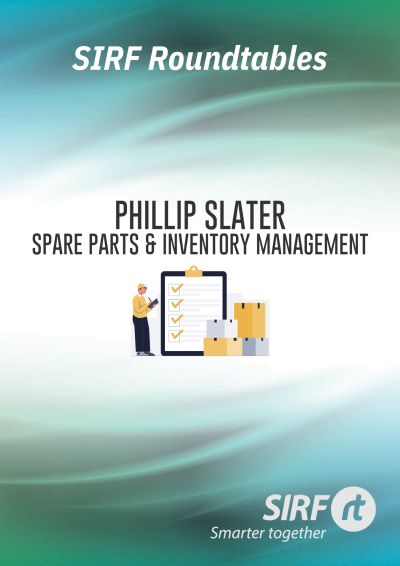Phillip Slater | Spare Parts & Inventory Management | Perth| 2 days | Jun 2024 | ISW
Event description
Phillip Slater - Spare Parts & Inventory Management
2 days Face to Face
Phillip is a globally recognised spare parts & inventory management subject matter expert. Nine time Author & multi award winning subject matter expert, Phillip takes trainees through all aspects of spare parts & inventory management. From new project inventory purchase "First-Time-Buy" to "Last-Time-Buy" to financial considerations, critical spares, rotable spares, what to stock, when to reorder and how much to order & all aspects of
managing spare parts & inventory control, Phillip covers it all in this course.
For those unfamiliar with Phillip's work, check out this 3 minute video

Course Outline
Identifying the spare parts that are critical to your ongoing operations is perhaps one of the most important and yet least understood aspects of spare parts inventory management.
Many companies have a working definition of criticality, but it is too narrow to be of any real value. Others set parameters that don’t really reflect the critical nature of the parts. And some companies seem to have a ‘wait and see’ approach that only defines criticality after the event! All of these approaches take a narrow view of MRO and critical spare parts management and can simultaneously expose the company to both increased inventory expense and greater risk of operational losses.
Effectively managing MRO and critical spare parts inventory requires an holistic approach that understands the full life-cycle of spare parts inventory management. This covers: initial forecasting, first time buy, categorization, defining criticality, setting ROP and ROQ, inventory optimization, last time buy, and managing obsolescence.
In the extensive two-day workshop, Phillip Slater will take you through the entire spare parts management life-cycle. This will enable you to implement a best-in-class approach for MRO and critical spare parts management.
This comprehensive workshop will cover:
• The uniqueness of spare parts management
• Financial considerations
• Metrics and reporting
• Policies and procedures
• Managing rotable and repairable spares
• Best practices
• Deciding what to stock
• Capital equipment and first time buy
• Identifying and managing critical spares
• Setting the Re-Order Point (ROP) and Re-Order Quantity (ROQ)
• Forecasting
• Inventory optimization
• Managing obsolescence, end of life, and last time buy
The workshop will be interactive with exercises and plenty of time for your questions.
Course Agenda
Day 1
Introduction
In the introductory session there will be an overview of the spare parts inventory life cycle and we will identify what are MRO and spare parts and why they different to other inventory types.
• Identify the characteristics that differentiate spare parts inventory from other types of inventory.
• Identify 5 common supply chain techniques that should not be used with spare parts inventory.
• Explain how spare parts management fits into the big picture of operations management.
Financial Considerations
Financial understanding is critical for putting spare parts management in to the business context. This session explores spare parts financial considerations and reporting.
• Explain the 5 key financial principles for spare parts management.
• Identify and interpret the key financial reports associated with spare parts management.
• Calculate the cost of holding spare parts inventory
Deciding What to Stock
The most important issue at the beginning of the spare parts life cycle is asking whether or not to stock an item at all. This session identifies 7 questions to ask before deciding what to stock.
• Explain the relationship between the Planning Horizon and Lead Time.
• Discuss the 7 questions that need to be asked before deciding whether or not to stock an item in inventory.
• Determine the requirements for selecting and stocking spare parts for new capital equipment (first time buy).
Setting Stock Levels
The second most important issue is deciding how many of an item to stock. This session will review techniques for determining spare parts criticality and from that setting justifiable ROP and ROQ levels.
• Identify critical spare parts and understand how to differentiate between machine critical and inventory critical spare parts.
• Explain the difference between theory and reality with determining spare parts requirements.
• Explain the problems with using traditional calculation methods for determining spare parts re-order points and re-order quantities.
• Apply a simple logical technique for determining appropriate re-order points and re-order quantities.
Day 2
Spare Parts Policies
Without appropriate policies there is no direction. In this session we review the suite of policies required to effectively manage spare parts inventory.
• Metrics and reporting
• Segmenting and categorizing spare parts
• Managing rotable and repairable spares
• The seven policies you must have for effective spare parts management
Best Practices
What does good spare parts management ‘look like’? In this session we will identify seven practices that make a genuine difference to spare parts inventory outcomes.
• Explain the process used to identify best practices.
• Identify seven practices that are shown to make a genuine difference to spare parts inventory management outcomes.
Inventory Optimization
This session explores three different techniques for spare parts inventory optimization and explains why some approaches to optimization don’t actually optimize at all.
• Explain the two groups of forecasting techniques and their pros and cons.
• Identify the three different approaches that can be applied for spare parts inventory optimization.
• Explain why some approaches to optimization don’t actually optimize at all.
Managing Obsolescence and Disposal
End of life management is an often-neglected part of spare parts inventory management. This session reveals the big lie of spare parts obsolescence and explains how to better manage the spare parts end-of-life.
• Explain the difference between vendor-led and owner-led obsolescence and the implications of each.
• Develop an End-Of-Life (EOL) plan and calculate Last-Time-Buy requirements.
Learning Outcomes
By attending this unique workshop, you will be able to:
• Apply critical thinking to identify, analyze, and solve spare parts inventory management problems.
• Develop and implement a spare parts management system appropriate to an organization’s resources and needs.
• Identify and differentiate critical spare parts and determine appropriate actions for stocking and supply.
• Evaluate existing and planned spare parts holding levels and determine if they are appropriate based on demand and supply constraints.
• Develop and critique sparing plans for both First-time-buy (capital purchases) and Last-time-buy.
• Plan for and identify opportunities for minimizing spare parts obsolescence.
This workshop will enable you to achieve meaningful change in the way that you manage your MRO and critical spare parts inventory.
Brochure:

About Phillip Slater
Phillip Slater is a spare parts management and MRO specialist. With more than 35 years’ experience Phillip has helped rebuild and reorganize MRO stores and spare parts management systems for asset-intensive organizations in 38 countries. While he is university qualified in both mechanical and maintenance engineering, Phillip’s greatest lessons in spare parts management came both from his time working as a maintenance engineer and operations manager, and through supply chain management consulting.
Phillip is the author of 9 books, including Spare Parts Inventory Management, Smart Inventory Solutions and The Optimization Trap and has been published more than 250 times in industry and trade magazines around the world. In 2012 Phillip was honoured by the Logistics Association of Australia with the Kim Rothwell Leadership in Logistics Education Award. In 2017 Phillip was awarded a Business Innovator Award by Corporate Vision Magazine.
Phillip is an approved training partner with the University of Tennessee and developed the Spare Parts Inventory Management University certificate program at the University of Kansas. Phillip is also the Founder of SparePartsKnowHow.com, an online training resource dedicated to spare parts inventory management and his training has been undertaken by people from more than 40 countries.
Testimonials
Phillip Slater is the world’s leading authority on the storeroom.
Doc Palmer, PE, MBA, CMRP
Author of McGraw-Hill’s Maintenance Planning and Scheduling Handbook
I can summarize my opinion about his deliverance of the objectives as simply brilliant and practical and his ability to train people is extraordinary.
Ali Abrar | Lead Support Engineer – Rotating Machinery | QAFCO | Qatar
This was the first time that I’ve seen something that can be practically applied on a daily basis by almost anyone and without the need for expensive software.
Probin Konwar | Head of Maintenance Planning | QAFCO | Qatar
There is no doubt that Phillip is the global spare parts guru.
Julian Gonzalez | Manager of Distribution | Coats | Mexico
I really enjoyed this training; it gave me a new perspective on inventory management.
Pieter Janssens | Production Support Coordinator | Longveld | New Zealand
It is hard to find classes that go into this detail.
Sondra Carroll | Manager-Supply Room Solutions | Shaw Industries Group | USA
I was really impressed with the material and content of the class. I learned a great deal and am working on applying that knowledge.
Jason Ashby | MRO Buyer | The Shepherd Color Company | USA
Phillip Slater’s training program helped my team to better understand the complexities of spare parts management, the application of policies, and the importance of maintenance engagement.
Askar Andirov & Sabit Trumov | Spare Parts Superintendents | KPO | Kazakhstan
His deep knowledge and experience allowed him to guide the conference discussions and enable the participants to get the most out of the day.
Sam Wardill | Senior Manager | GRA | Australia
Some comments from past workshop with Marcus Evans - without attribution
"I have been provided with a lot of useful information that I plan to take back to my workplace and put into action"
"Great package of what I work in every day, great tools to try out."
"I would recommend this workshop.”
"This has been an invaluable workshop- would recommend this for any persons in inventory"
FAQ's
WHAT COMES WITH THE COURSE?
Each participant will receive a workshop workbook for recording their notes and completing the various exercises. In addition, by completing the sections in the workbook they will, over the course of two days, build a plan for developing and achieving a consistent spare parts management process that delivers the results they need.
WHO SHOULD ATTEND?
This course is applicable to everyone from procurement, maintenance, stores and anyone wanting to better manage spare parts & inventory.
WHEN DO I NEED TO REGISTER BY?
Bookings open until the Friday before the event unless sold out
WHO CAN I CONTACT FOR MORE INFORMATION?
Jeff +61 409 535 239 or info@sirfrt.com
Please contact us for group booking discounts
Tickets for good, not greed Humanitix dedicates 100% of profits from booking fees to charity



